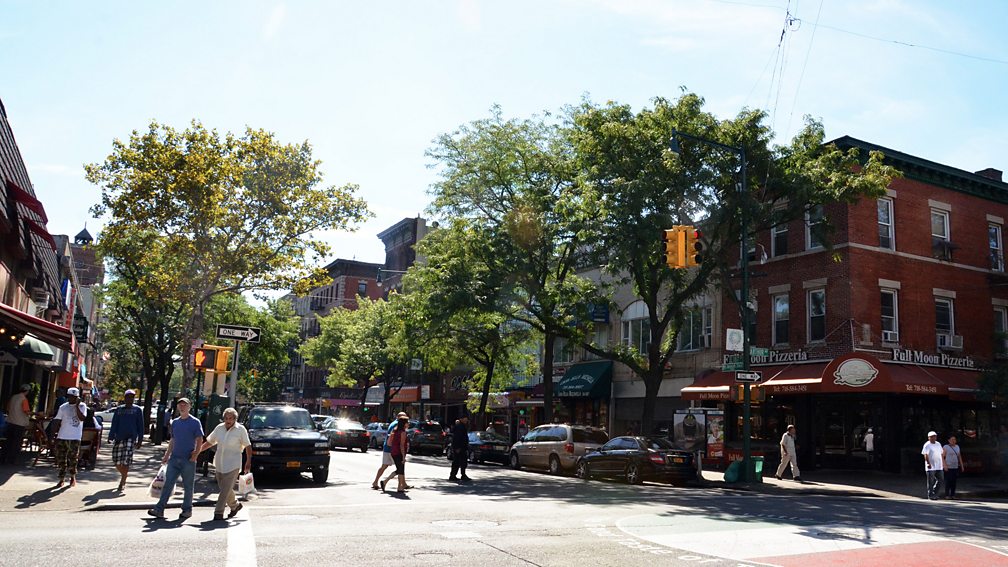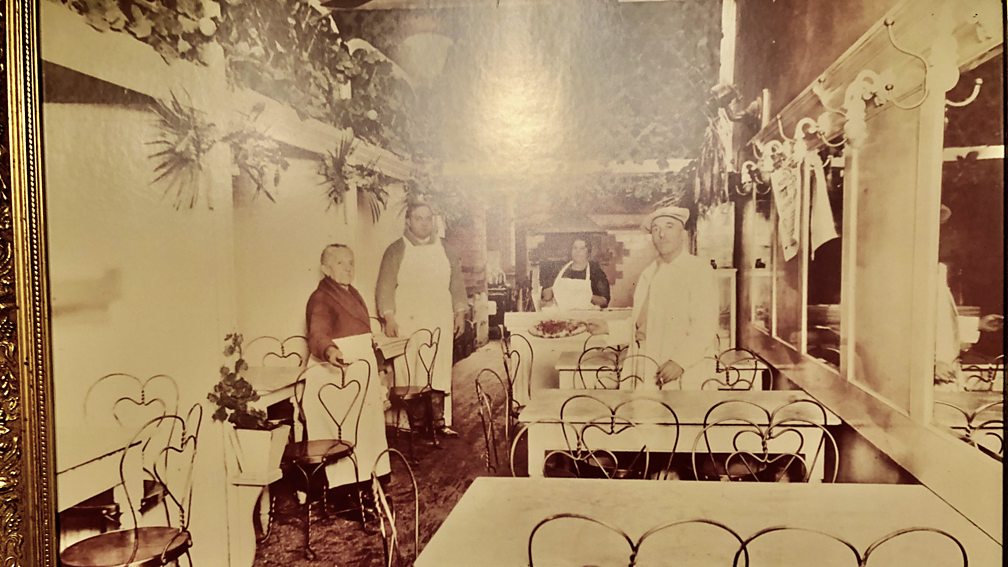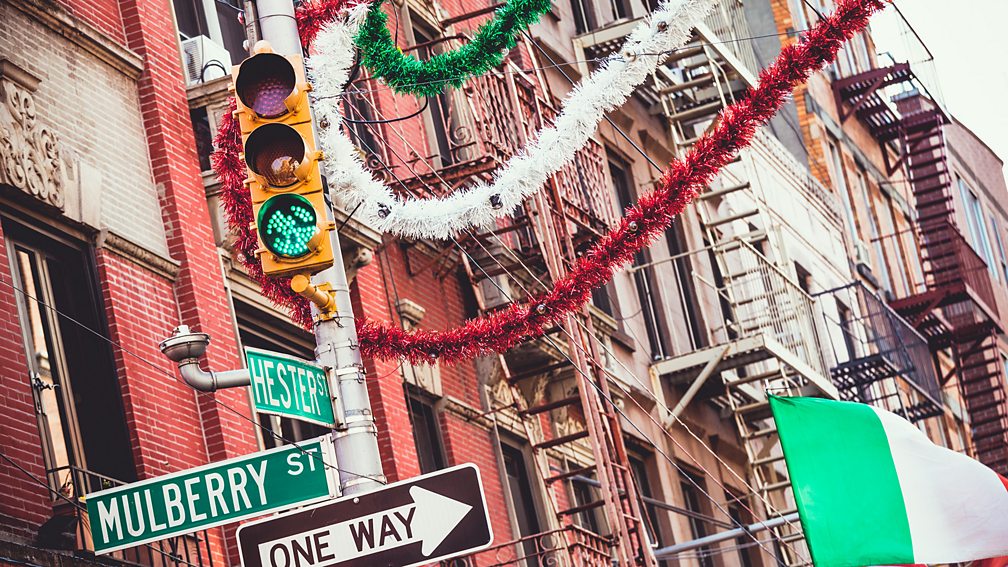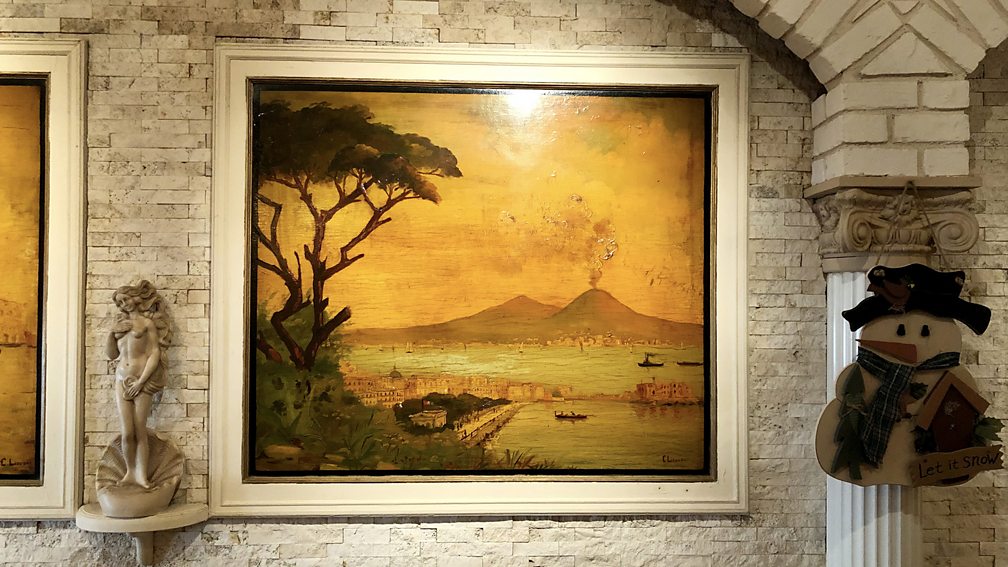New York’s ‘real’ Little Italy

For more than 100 years, Mario’s on Arthur Avenue has maintained the culinary traditions of New York’s early Italian settlers.
It’s a dark winter evening on Arthur Avenue in the Bronx. Shopkeepers are bringing in tins of olive oil and tomatoes from sidewalk displays and pulling down the metal grates in front of their bakeries and butcher shops. As the surrounding shops darken, the narrow windows of Mario’s restaurant glow, beckoning hungry diners inside where the Blue Grotto of Capri glitters and Mount Vesuvius looms over the Bay of Naples in a series of 85-year-old oil paintings.
“Some customers have told me to get rid of them, [saying] they’re too dark, too old fashioned,” said co-owner Regina Migliucci-Delfino, of the paintings made by her great-uncle, Ciro. “But this is our history.”

Mario’s is the oldest restaurant in one of the most intact Little Italy’s in the United States. Unlike Little Italy in Lower Manhattan, which has shrunk to little more than a kitschy tourist strip, New Yorkers know Arthur Avenue as the Big Apple’s “real Little Italy” – a neighbourhood where more than two dozen Italian shops and restaurants have been in business for 50 to 100 years. Most shops are owned and operated by the third or fourth generations of the families who started them, and a handful have been sold to long-time employees who have kept things the same. Italian-Americans living in the suburbs drive in each week to do their shopping here, and when tourists from Italy arrive on sightseeing buses each day, they marvel at foods they haven’t seen since their grandmothers made them. Mario’s epitomises the neighbourhood’s time-capsule feel, and is perhaps the most authentic place to taste the culinary traditions of New York’s early Italian community.
On a recent visit, Joe Migliucci, Mario’s son, overlooked the dining room from the kitchen door. His signature suspenders were punctuated with a round pin that read, “I’m the Boss”. He’s 80, but to me he looks exactly the same as he did 30 years ago when I was a young girl and he spotted my brother and I looking bored during a long family dinner. He offered us some pizza.

Pizza at Mario’s is an Oteri family tradition. My great-grandparents, also from Naples, owned a baccalà (dried and salted cod) shop just a few doors down on Arthur Avenue from 1918 to 1980, and always said that Mario’s made the best pizza. A century later, Mario’s remains our family restaurant. When my mother passed away and we were at a loss as to where to have Christmas Eve dinner, we chose Mario’s because it felt like home. Today, my family is one of the restaurant’s hundreds of generational customers.
The Migliucci family left Naples in the 1890s after Joe’s great-grandfather (also named Mario) had his hand blown off by fireworks. Ashamed of his disfigurement, the couple and their children moved to Cairo, Egypt, where they opened an Italian restaurant. Their son Giuseppe married a Neapolitan woman and returned the entire family to Italy. Then in 1913, the couple moved to Manhattan with Giuseppe’s mother, Scolastica, and their 1-year-old son, named Mario after his grandfather.
You may also be interested in:
• The truth about the US' most iconic food
At the turn of the 20th Century, the Belmont neighbourhood that holds Arthur Avenue was a rural hinterland that real estate developers marketed to Italian immigrants as the “Italian colonies”. And so it was here at 2342 Arthur Avenue in 1919 that the family opened G Migliucci, a pizzeria with just six tables. Scolastica and her daughter-in-law cooked simple dishes like escarole in broth and Giuseppe made pizza. After school, young Mario worked at the restaurant selling slices of pizza on the sidewalk for five cents. His friends would come by for a slice and called the restaurant “Mario’s”.

Mario and his brother Clemente took over in the 1930s, officially changed the name and transformed the pizzeria into a white-cloth, fine-dining restaurant. The restaurant soon grew into one of New York’s most celebrated, attracting mayors, governors and celebrities like Joe DiMaggio, Frank Sinatra and Elizabeth Taylor. In 1971, director Francis Ford Coppola wanted to shoot a scene from his new film The Godfather in Mario’s dining room. But when Mario heard the pitch – that Al Pacino’s character would hide a gun in the restaurant’s bathroom and then use it to kill the two men at the table – he declined, saying that it didn’t sound like a family film, so Coppola shot it at another nearby restaurant instead. And in 1976, New York Times food critic Craig Claiborne invited Mario and Clemente to cook at his home in the Hamptons with celebrated French chef Pierre Franey and published a glowing review of the restaurant.
Today, Joe always corrects diners who refer to his iconic restaurant as “old-school Italian”. “It’s Neapolitan cuisine,” he says in a soft voice.

When Mario’s opened in 1919, pizza was strictly an Italian dish that was almost exclusively found in Naples. Sixty five years before the True Neapolitan Pizza Association (AVPN) declared that “real” Neapolitan pizza could only be made with tomatoes grown on the plains of Mount Vesuvius, local buffalo mozzarella and double-zero flour, Neapolitans abroad adapted their city’s age-old recipe to their new environments and made pizzas with the best of what was available locally. Since the only buffalos in New York City lived at the nearby Bronx Zoo, the Migliucci’s topped their pizzas with cow’s milk mozzarella.
Though Mario’s’ menu has evolved, pizza, made exactly as it was in 1919, has never left the menu – a culinary artefact showing how the dish was introduced to Americans by immigrant chefs. Unlike most New York slices today, which often come topped with a heavy layer of grated mozzarella and provolone that overwhelm the tomatoes, Mario’s places a perfect blend of tomatoes and fresh basil leaves alongside dollops of fresh hand-sliced mozzarella. And while it’s now de rigueur for New York pizzerias to build or even import wood-fired pizza ovens from Italy, Mario’s has stuck with its gas oven so that the pizza crust is perfectly crisp.
Other time-capsule dishes at Mario’s include braciole (rolled beef) with peppers and escarole in broth, and tripe cooked with tomatoes and onions. Spiedini alla romana (skewered bread layered with cheese, deep-fried and dressed with anchovy sauce) was once ubiquitous on Italian restaurant menus, but it has fallen out of fashion everywhere except Mario’s. Heeding my great-grandparents’ advise, I, of course, ordered the pizza.

These days, Joe may be the face of Mario’s, but the boss is his daughter, Regina, who manages Mario’s three dining rooms on two floors. As the fourth generation of Migliuccis to work at Mario’s, Regina started working at the restaurant on Saturdays when she was 11 years old, answering phones and helping with paperwork. When customers straggle in between the lunch and dinner rushes, she smooths back her thick chestnut hair and greets them with menus.
When I asked Regina about her family’s paintings of Naples adorning the dining room walls, she looked at the generations’ worth of yellow varnish that now coats them and said, “I’m pretty sure [Naples] doesn’t look like that anymore.”
She’s right. The dreamy, brush-stroked Bay of Naples enshrined inside Mario’s is now filled with luxury hotels, cranes and busy cruise ships – not that she’d know that. Remarkably, neither she nor her father have ever visited Naples, or anywhere in Italy, for that matter.

When I asked why, she and Joe looked at each other and laughed. The answer was simple: time. Mario’s is their life’s work and Regina and Joe both work six days a week, cover for other staff members and even help out in the kitchen. Mario’s shuts down for two weeks every August. One week is used to deep clean the restaurant, and the second is theirs to rest – but the two have always opted for easy getaways to the Caribbean. And while many of their family members in New York have returned to meet their relatives in Naples, Joe and Regina have never tasted the limoncello grown by the Blue Grotto, seen Mount Vesuvius at sunset or gone to any of the places painted on Mario’s walls.
A contemporary connection to Naples is now maintained by chef, Massimo Celso who spent 10 years cooking at Mario’s, returned to his native Italy, and then came back to the Bronx to head the restaurant’s kitchen. He mastered all the dishes that Mario’s is famous for: the spiedini; octopus salad; meatballs slow simmered in tomato sauce. Celso is also the first person outside the Migliucci family to have the title of head chef in their 101-year history.

While all of Joe’s children, nieces, nephews and grandchildren have worked in the restaurant, they were each encouraged to go to college and choose a less-gruelling career than the food business. Mario always tried to discourage Joe from following him into the family business by giving him the worst jobs, like taking out the rubbish and cleaning out the grease traps. When Joe said he’d like to work in the family business, Mario insisted Joe go to college. But Joe said he preferred to be around people.
A few days after my visit, I returned to Mario’s to find Regina’s 17-year-old son, Damian, helping his grandfather in the restaurant. Side-by-side, it was easy to imagine what Joe looked like at Damian’s age, as they share the same profile and gentle demeanour. Damian told me that, like his grandfather, what he likes best is meeting people – even if sometimes they’re not the nicest. Just then, Joe walked by and said, “If they’re not the nicest, you be the nicest. That’s what you learn when you’re here.”
I asked Damian if he thinks he might take over Mario’s someday. He looked at me and said, “Time will tell.”
Join more than three million BBC Travel fans by liking us on Facebook, or follow us on Twitter and Instagram.
If you liked this story, sign up for the weekly bbc.com features newsletter called "The Essential List". A handpicked selection of stories from BBC Future, Culture, Worklife and Travel, delivered to your inbox every Friday.
{"image":{"pid":""}}